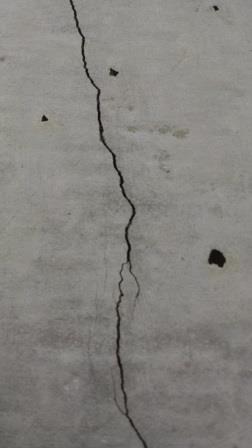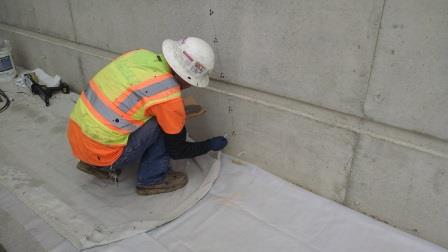Los Angeles International airport is not only the 6th busiest airport in the world with over 165,000 people passing through daily — it’s also an architectural icon thanks to the sweeping mid-century arched Theme Building that received a much-needed facelift completed in 2010. The airport as a whole is currently undergoing massive renovations and new construction from its runways to its parking lots.
Keeping in the spirit of an aesthetically centered city, the new Tom Bradley International Terminal was built with everything from high-end shops to trendy restaurants. Even its massive exterior walls were designed to please the eye. Unfortunately, like a hard partying starlet, the cracks began to show a bit too early.
The Los Angeles Airport Authority (LAWA) stepped in and hired Angelus Waterproofing and Restoration, Inc. to get to the root of the cracking issue. They would need to repair and waterproof 200,000 square feet (18,580.6 m²) of 12-inch-thick (30.5 cm) concrete walls. The catch? The finished project had to resemble the original architectural concrete.
Same Same, But Different
Stephan Claus and Shaun Geiger, respective president and CEO of Angelus, were selected for the difficult job. “LAWA hired a contractor to build the new Tom Bradley Terminals, and they didn’t include any expansion joints thinking the slab was thick enough that they weren’t needed. As a result, that caused micro-cracking, structural cracking, and just an overall unsightly appearance that allowed water to enter,” Claus explained.
The cracking was so bad, in fact, that the smaller cracks resembled a shattered mirror. Geiger added, “Aesthetics were super important, so the spec was very unusual. The owner’s rep said they didn’t want to change the look of the gates and walls, so that was the challenging thing. How do you waterproof something and make it look like we were never  there? So that took a while to figure it out.” The agreed upon solution was KOSTER’s urethane-injection at all cracks, followed by an application of Sinak Color Cap, which is a stain/coating that mimics the look of architectural concrete.
there? So that took a while to figure it out.” The agreed upon solution was KOSTER’s urethane-injection at all cracks, followed by an application of Sinak Color Cap, which is a stain/coating that mimics the look of architectural concrete.
The process began by injecting the KOSTER IN5 urethane foam into cracks using a low-pressure Seal Boss P3003-2C. Then, they stripped the existing patching material, which at first the team was very hesitant to remove. Once the old patching material was removed, the crew injected a patching material from Simpson that they could use to fill the cracks and then peel away. Any materials remaining were sanded. A Sinak ColorCap coating in storm gray was then applied and cured.
According to Claus, “once the cracks were cured and prepped, we would lightly sand the matrix, then apply the Sinak ColorCap that had been diluted to the proper ratio. It was fogged on with a spray rig, a Titan SpeeFlo Hydra M 4000, then we would add another two to three coats, which, being a stained sealer, would be about one to two mils [25.4–50.8 microns] thickness once dry.” The crew, sometimes using booms to access higher areas of the walls, would then move to the next gate area, always mindful of the active airport gates and working closely with the gate managers.
Keeping up With the Changes
Once it came time to present the first completed portion, the reaction was a bit unexpected. Geiger explained, “Once we completed the test wall for review we were met with, ‘Nope, nope we don’t like it!’ despite the fact we did what was specified. Since the wall couldn’t look like it was painted, we had to figure out a way to make the coating look like the architectural concrete, so we had to do a faux concrete look and applied different colors in different directions, modifying the spec to get the desired aesthetic.”
The process was revised, and the remainder of the project continued for a total of 12 months utilizing a crew of eight workers. The day to day work, however, wasn’t without its challenges. Claus noted, “We were working in active gates at the Tom Bradley International Terminal, within feet of jumbo jets that are worth tens of millions of dollars, along with tight security.” The team had to undergo background checks, airport badging procedures, and driving tests, and they had daily escorts to the jobsite. “You couldn’t just pull up and start working,” Geiger said. “And it was a long process to get on site and off site. Guys parked at the construction trailers, then our Angelus pick-up truck, which had been bomb checked and given a special flag, would drive through the active runways to the gate, communicating via radio with the ground control tower.”

Other than the security procedures, other concerns, such as safety and environmental restrictions, were standard and without any issue. All water from the water blasting was run to the sewer line; that plan was explained by LAWA and easily followed. The only weather concerns were rain and fog, as the walls had to dry before work could begin. “The marine layer was there all the time, but didn’t really hinder our timeline. We would adjust the schedule if there was too much dew or it was too cold,” Claus noted.
As far as the crew’s safety, the team members followed regulations while utilizing booms or on the roof, wore safety harnesses, hardhats, gloves, and goggles, and had fire extinguishers handy at all times just in case.
High Expectations
Angelus Waterproofing and Restoration has been specializing in waterproofing and building restoration for more than 30 years and has experience working on projects at the Dallas/Ft. Worth Airport, including gate restoration and runway striping. Their project and waterproofing expertise ensured that this high-profile project would be a soaring success.